This Passion Week as the world celebrates 100 years of the birth of Sayed Haider Raza one recalls his love for churches and Christian hymns sung during the days of the Stations of the cross.Raza would walk down to the little church near his home with his wife Janine.” The sound of the hymns being sung when listened to as an outsider is an experience to keep in one’s memory,” said he during his last days in the city of Delhi.
Hymns for Raza were an initiation into the moments that awaken our senses towards an earth song.He said his works took on a poetic rhetoric because of his love for both bhajans and hymns.Raza was also a great lover of Sant Kabir Das’s poetry.It is from Kabir’s Dohas that he brought forth the idea of the five elements or the panchatatva.
At Grosvenor Gallery in London there are five works that bring back the archival essence of the beauty of memory and nostalgia for an artist who loved the rhythms of the landscape that he looked upon.
Untitled 1979
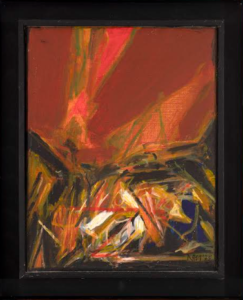
After moving to France in 1950, Raza began to work in the styles of the École de Paris. He saw the paintings of Post-Impressionists like Cézanne, Gauguin and Van Gogh and began to use colour as a tool of construction, switching from gouache and watercolour to more tactile oil-based pigments. In Untitled 1979 we see that overtook construction, and Raza’s landscapes of the French countryside
became less about tangible representation and more about the mood they evoked in the artist. The slow creeping of twilight tenors in smoky embers unveil a certain mood. The flaming stroke that runs through the top seems the epitome of the Sandhya, the sunset that evokes multiple evocations.
Untitled 1979
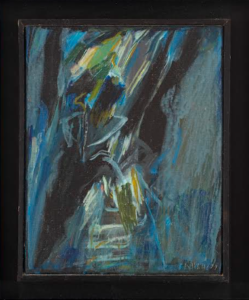
Untitled 1979 is about a midnight mood of the moonlight. Raza was a lover of the moon as well as the moonlight. The strokes of grey and blue amidst the midnight shades of darkness evoke an essence of a starry night.It brings back the lines of the beautiful song by Don Maclean in which he says :Starry starry night, paint your palette blue and grey. Colours in this canvas are deepened, and there is an endless play of tones . We can see his love for exploring manifestations of the colour structure that varied in expansive segments from centrifugal rhythms to contain the complexities of the composition.
Untitled 1977
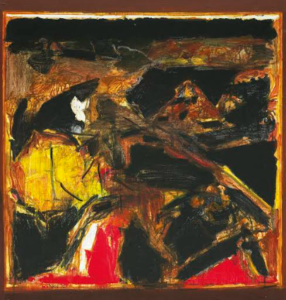
In the ochre toned 1977 acrylic on canvas we can sense an angry summer tempest, a cadence perhaps of villages tumbling down forested hills – as it swims through thick swathes of vivid primary colours. To allow his brushstrokes and use of space to become freer and even more expressive, Raza began to use quick-drying acrylic paints. It was also in this period of gestural expression, sometimes termed ‘lyrical abstraction’, and we think of the Indian summer and its latent heat. Not only did Raza draw on his memories of growing up in the forests of central India, but also on traditional Indian theories of colour and aesthetics, Sanskrit and Urdu poetry, and teachings on visually-guided meditation. The use of colour in Indian miniature paintings, particularly those from Pahari and Rajasthani schools, became an important point of reference for the artist.
Germination 1987
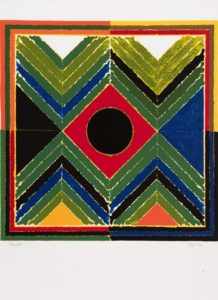
Raza often quoted poet Kabir Das and his bija (seed) dohas; this work germination is one that developed from his gestural masterpieces of the 1970s, we see that a regimented form began to take over from the artist’s expressive strokes, and geometry emerged as the main organizing principle. Much like tantric mandalas, Raza started using diagonals, triangles, squares and circles to symbolize natural phenomena and the cycles of the universe. Colour remained central, gaining an additional symbolic dimension, with the primary hues now representing the five foundational elements of Nature – earth, sky, water, fire and ether (panchatatva) . At the heart of these compositions was the opaque black bindu, representing the beginning and end of all energy and creation in the cosmos, and the source of all colour.The Bindu then became the black sun, the orb of both life and its end embracing the journeys therein.
Bindu 1982
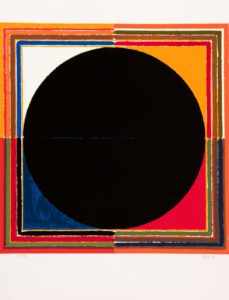
Bindu 1982 brings us to his seminal edifice of the dot that became his leitmotif. Its significance evolved from decade to decade through Raza’s career, and it remained the most important component of his work till the very end of his life. An understanding of the aesthetic relevance of the Bidnu is contained in its blackness. “We see that his colour cycles are matched by a conceptual stream which continuously archives deeper ravines. This restless craving for a renewal of means and methods is the essential aspect of the works of Raza.” (Y. Dalmia, ‘The Subliminal World of Raza’, A Life in Art: S.H. Raza, New Delhi, 2007, p. 199).
Click to read the article online

